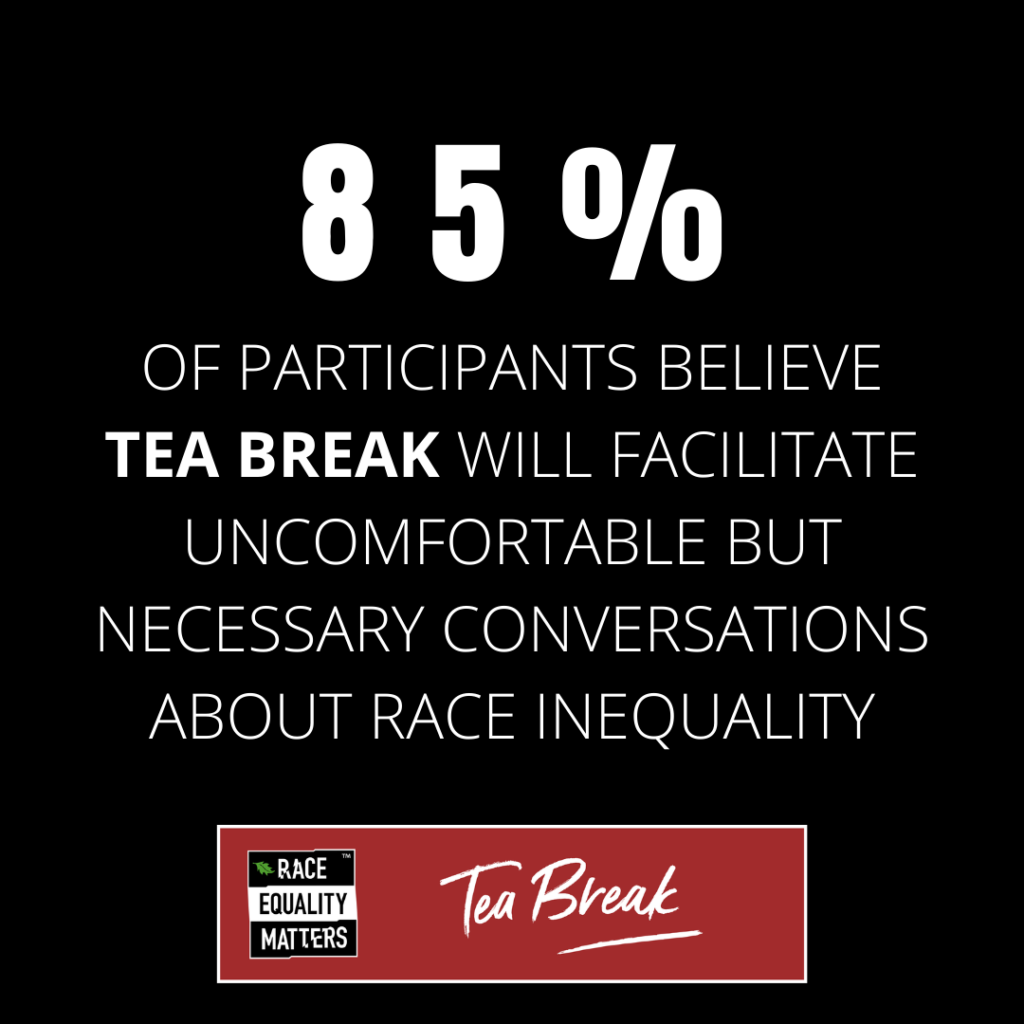The Tea Break provides the framework and opportunity for an organisation to hear the honest voice and feelings of its colleagues about race inequality. It was established through the Solutions Collaboratory™ in collaboration with Network Rail and its employee race network, Cultural Fusion, Mental Health First Aid England and those with lived experience from other organisations.
One year on from its launch, we hosted our virtual workshop, ‘How to Do it Right’, on 21st April to provide attendees with information from methodology experts and those with lived experience of the initiative. We combined an overview of the Tea Break’s ‘How to do it Right Guide’ with insight from Tea Break experts, Sharon Salmon and Sonia Hazel, at Network Rail. This event received interest from over 700 individuals from over 550 organisations across the UK, spanning from Glasgow to Southampton.
With 95% of attendees stating they would recommend the event to others, here are our 5 key tips to establishing, running and maintaining a successful Tea Break within your organisation.
1. Create and maintain a safe space to ensure members’ well-being
The first step any Tea Break initiative should take is to ensure psychological safety of its members. The safe space of the Tea Break must prevent fear of judgement and other concerns that can prevent employees from having necessary conversations. A safe space ensures the well-being of individuals and leads to felt change within organisations.
With 85% of attendees believing Tea Breaks will facilitate uncomfortable but necessary conversations on race inequality, a safe space can be achieved by:
- Providing options for members to provide anonymous feedback and points through an online chat function.
- Not filming or publicising the Tea Break, unless previously stated for an important and approved reason.
- Follow up with individual mental well-being checks, especially if some members were visibly upset during the meeting. Mental Health First Aiders may be best suited to this role.
2. Choosing a good facilitator(s) with the necessary skills is crucial for successful conversations
Often the facilitator and/or lead of the Tea Break seems like an obvious choice, however our Tea Break experts emphasise the importance of this decision. The group must consider the skills and confidence, but most importantly: Who can provide the platform to optimise discussion?
Members of the Tea Break should consider the following when deciding on the facilitator role:
- The facilitator needs to feel confident and knowledgeable on the topic but does not need to be an expert on it. Their role is to facilitate conversation, not dominate it.
- Facilitators need to be good listeners and foster inclusion of all members. Often Mental Health First Aiders are a natural choice for this role.
- Being the group facilitator is a big responsibility for one individual and using rolling facilitators (on varying timeframes) allows for responsibility and opportunities to be shared.
3. Select popular and relevant themes that will enhance discussion and attendance
The themes your Tea Break selects should be interesting and relevant to members in order for honest conversations to begin. Our experts advise that members should be given the opportunity to make suggestions to ensure the effectiveness and attendance of weekly Tea Breaks.

Some of the themes our attendees suggested included:
- Mental health and racial inequality
- Challenging racial stereotypes and stigmas
- Intersectionality
- Ethnic pay gap
- Terminology
- Allyship
- Recruitment and career progression
- Societal issues eg. the impact on black colleagues when the 3 black England players missed a penalty at the Euros, is Ukraine different to Syria, Afghanistan or other wars outside Europe and Child Q
4. Ensure the Tea Break framework is flexible and evolves to the needs and interests of members
Users should utilise the ‘How to do it Right Guide’ as a guide to facilitate important conversations for creating effective change in the workplace, not a rigid instruction. Sonia Hazel recognised the ‘definite evolution’ of the Tea Breaks within Network Rail since 2020 and emphasised the importance of such change.
To facilitate the adaptation and evolution of your Tea Break, you can:
- Debrief, review and monitor progress of the events, utilising feedback from all individuals.
- Balance consistency with flexibility through holding regular Tea Breaks on various days and times. This may increase attendance of shift and part-time workers.
5. Give it a go today! Ignore the reasons why it won’t be ‘perfect’ and take the leap towards change within your organisation.
Addressing and speaking about racial inequality can be uncomfortable and daunting, but the ‘How to do it Right Guide’ provides a framework to make the process as manageable as possible. The Tea Break experts advised attendees not to place too much pressure on yourself when running events for the first time as there is no ‘perfect’ model. Over half of the organisations that attended plan to implement Tea Breaks before October 2022- you could too!
Getting started is often the hardest step to make, so to help you can:
- Start with scheduling shorter Tea Breaks (30 minutes as a good starting point) to make it appear less daunting for members to attend. Often Tea Breaks work best in hourly slots but starting off shorter can help.
- Introduce the role of a ‘co-host’ who can help with leading the discussion and use questions as an icebreaker method.
- Have confidence that you can enable change collaboratively through courageous conversations. This can be, and has been, used as a tool to achieving workplace racial equality as over 75% of attendees consider the Tea Break more effective at tackling racial inequality than other diversity and inclusion initiatives.
For more information, watch the recorded event, download our ‘How to do it Right Guide’ and engage with our socials to help create shared solutions.

